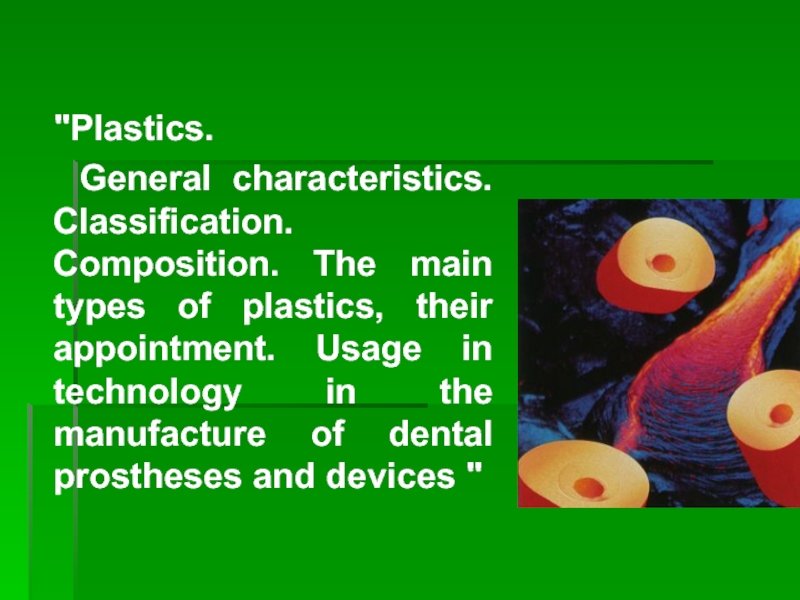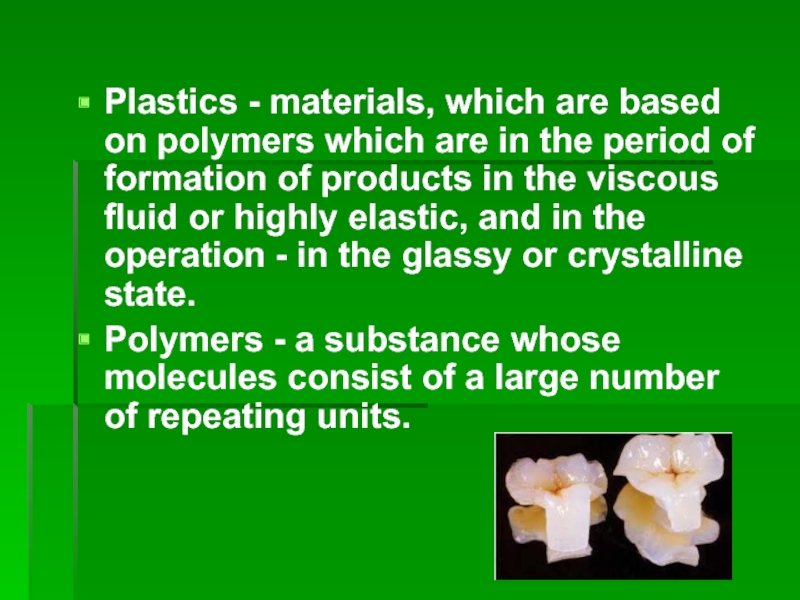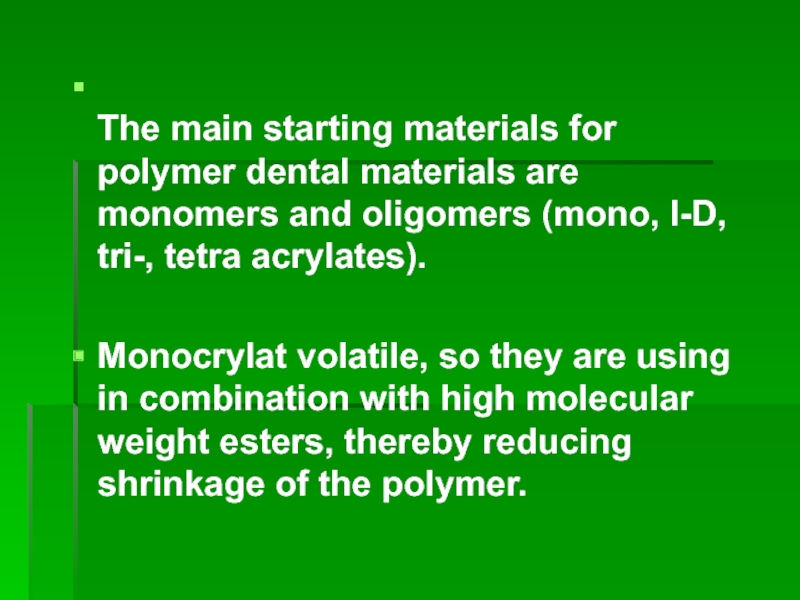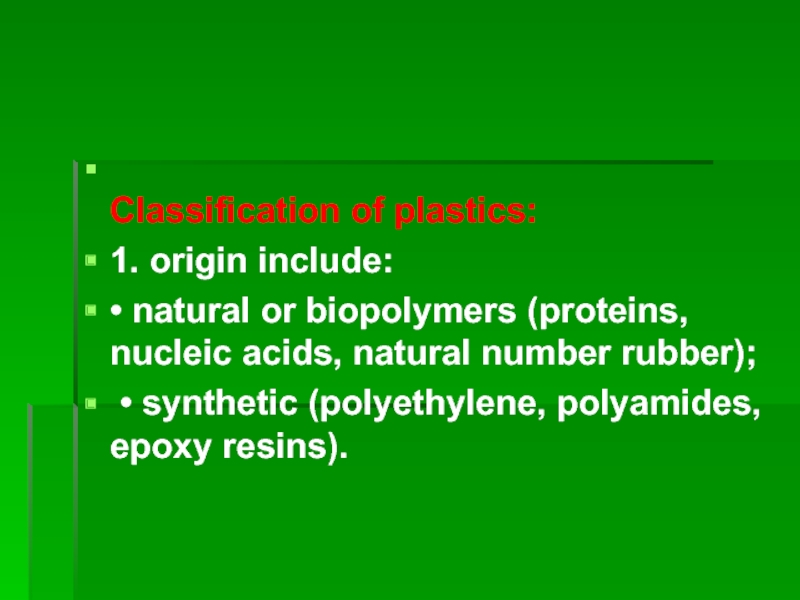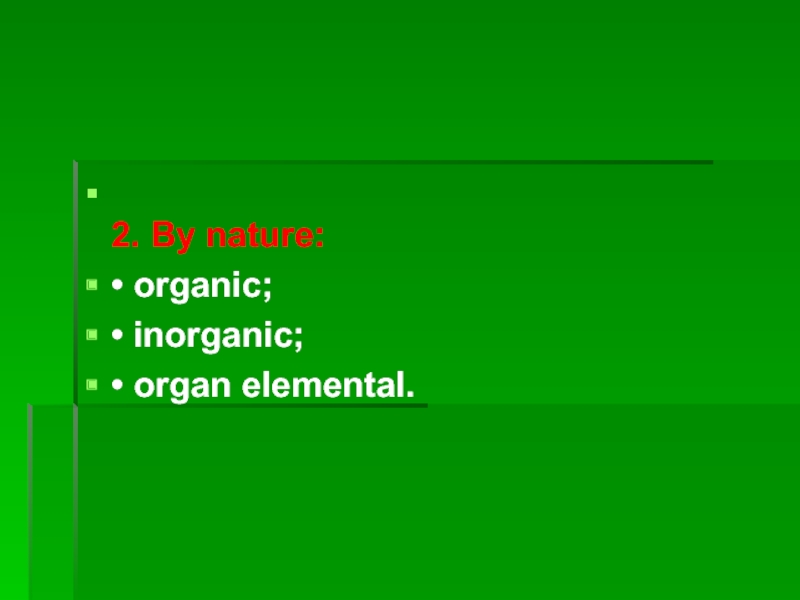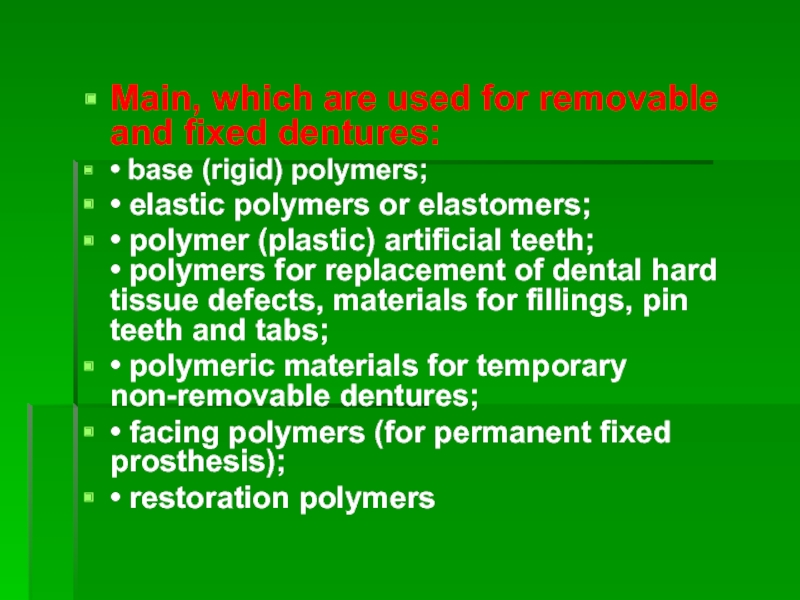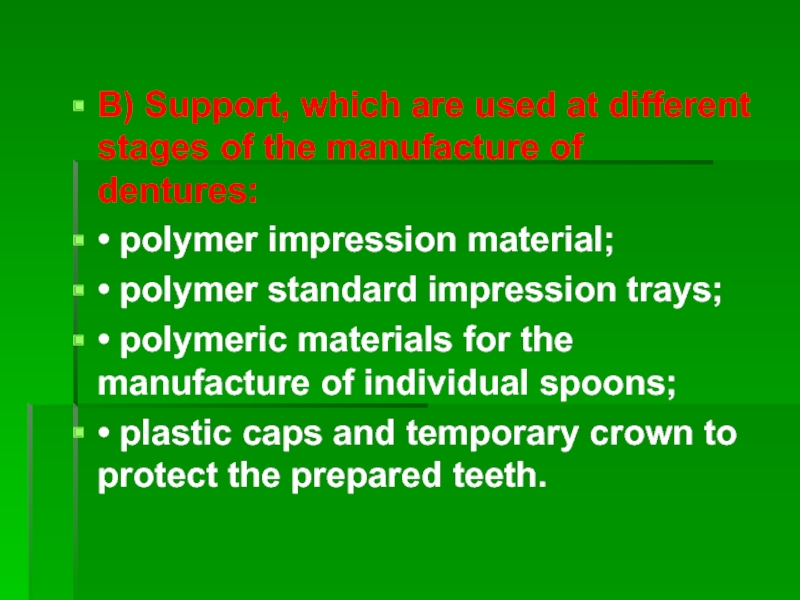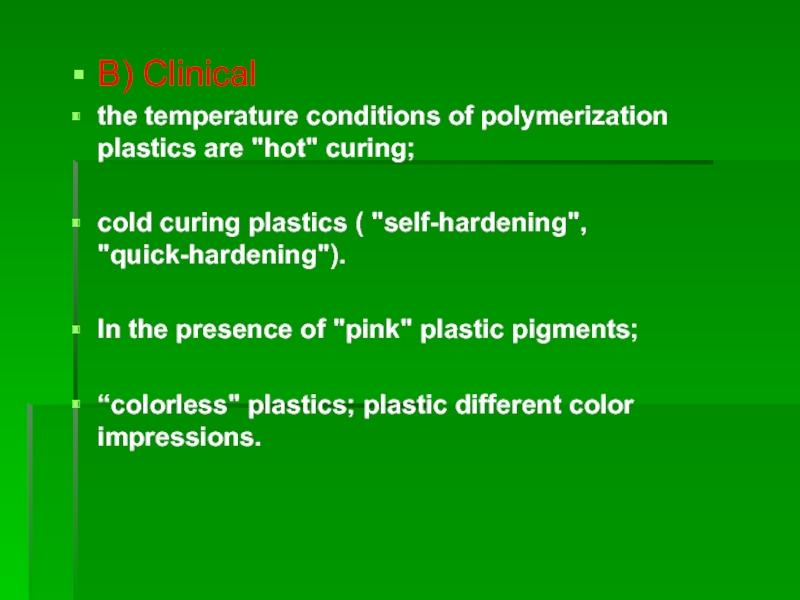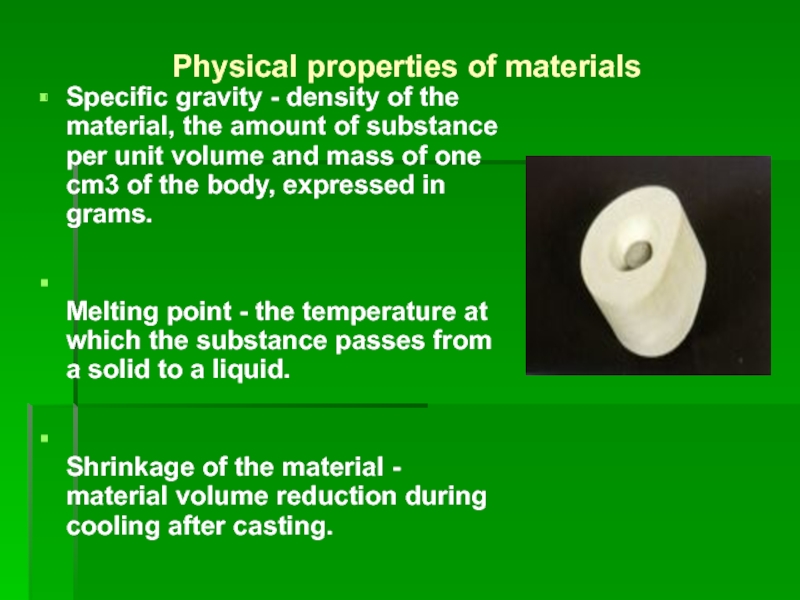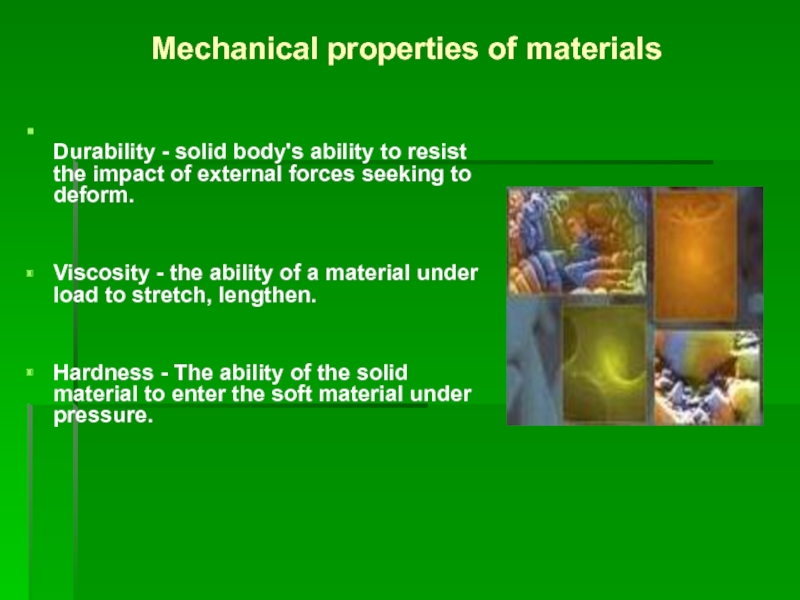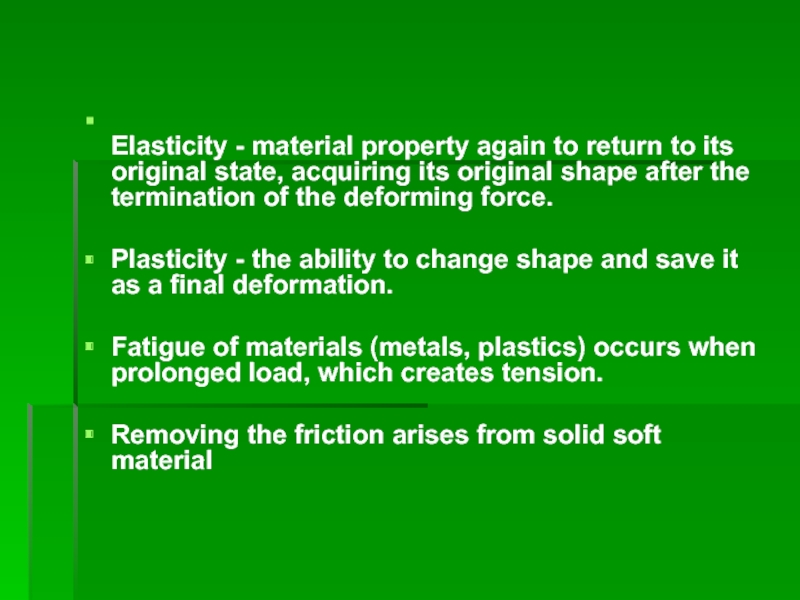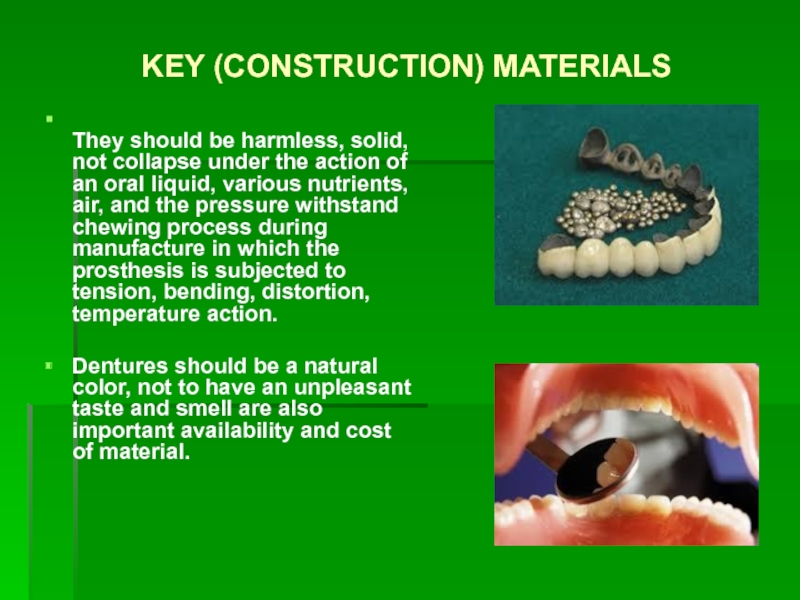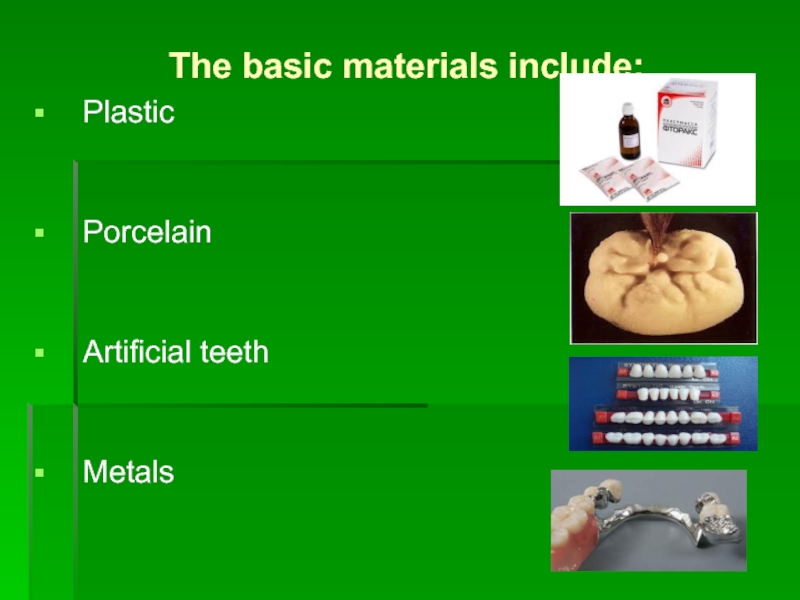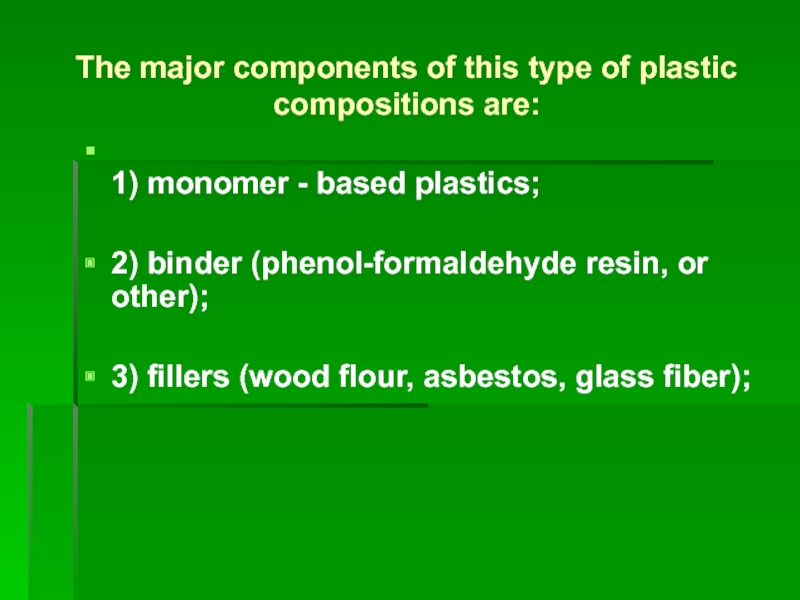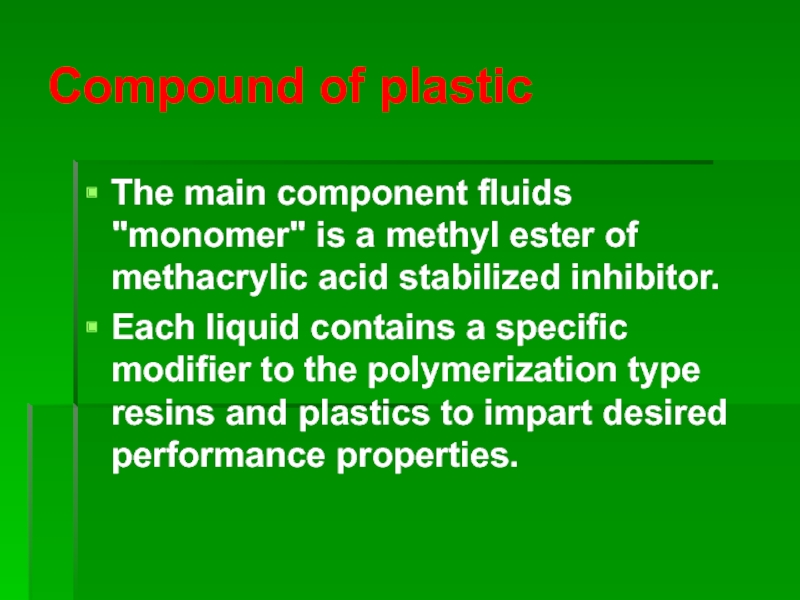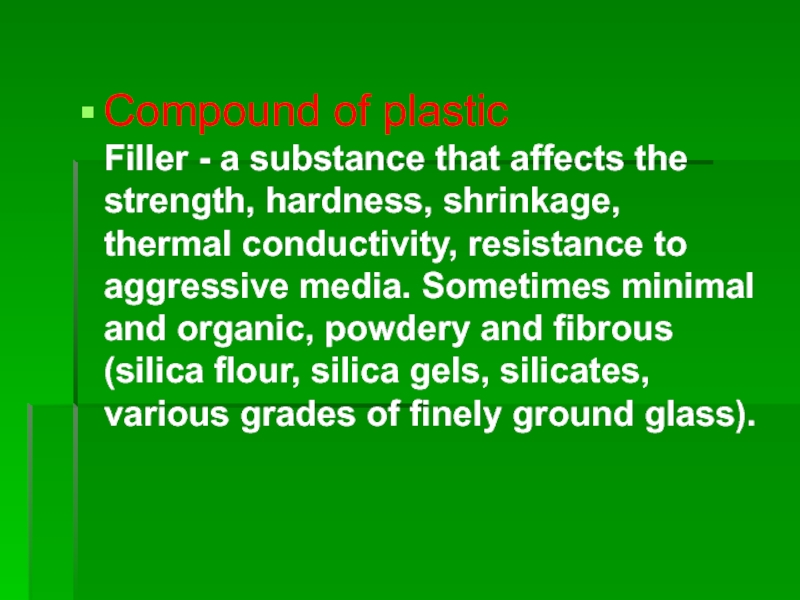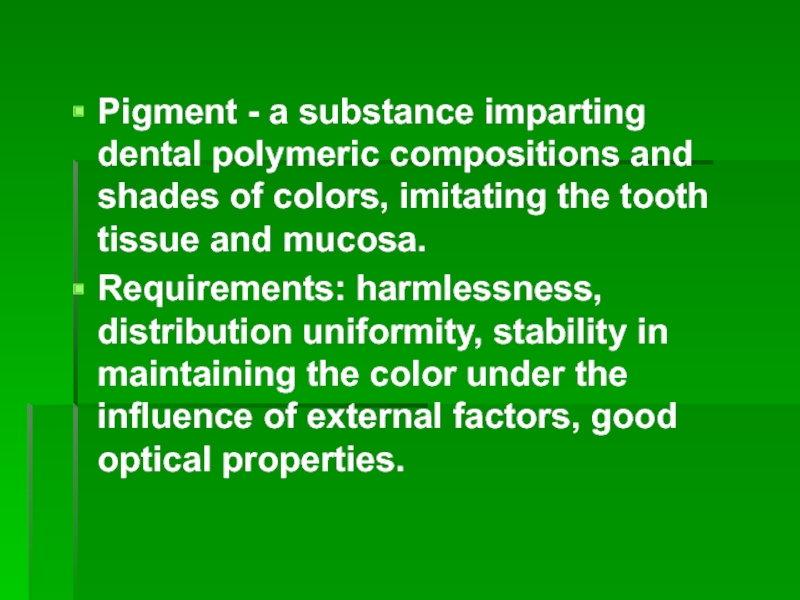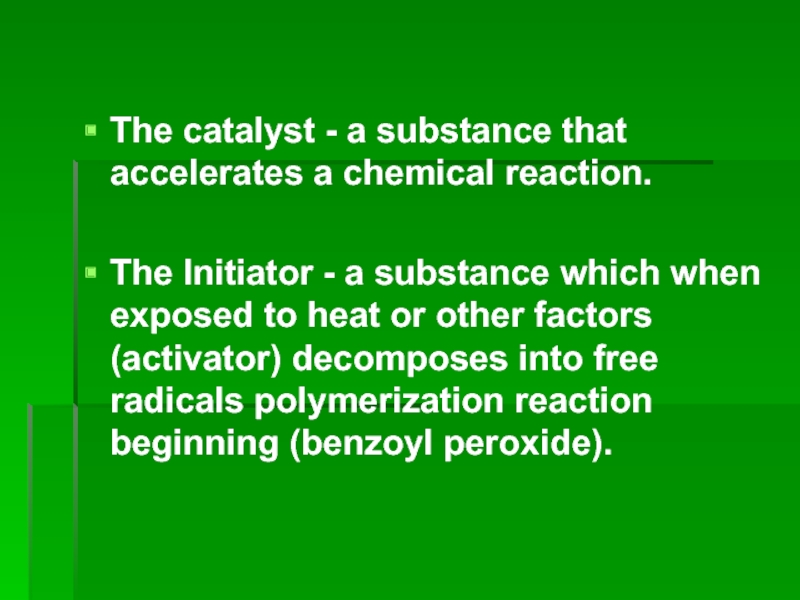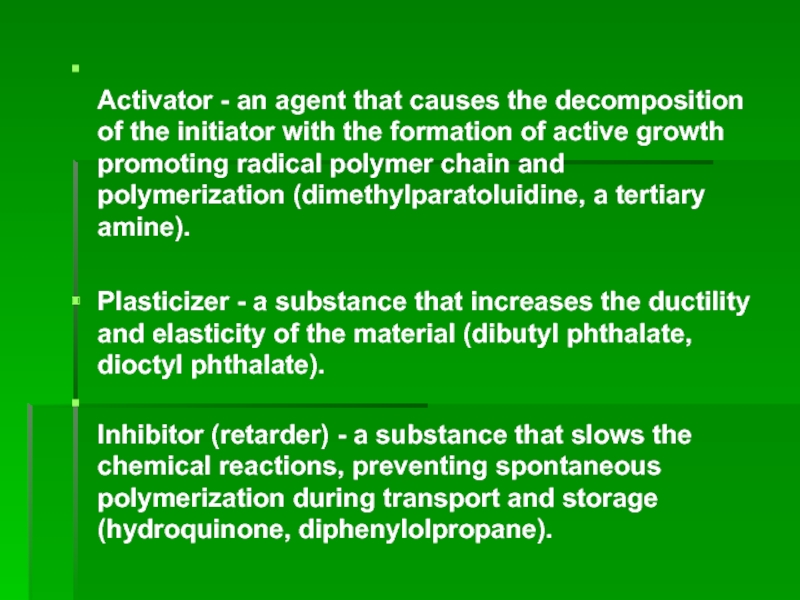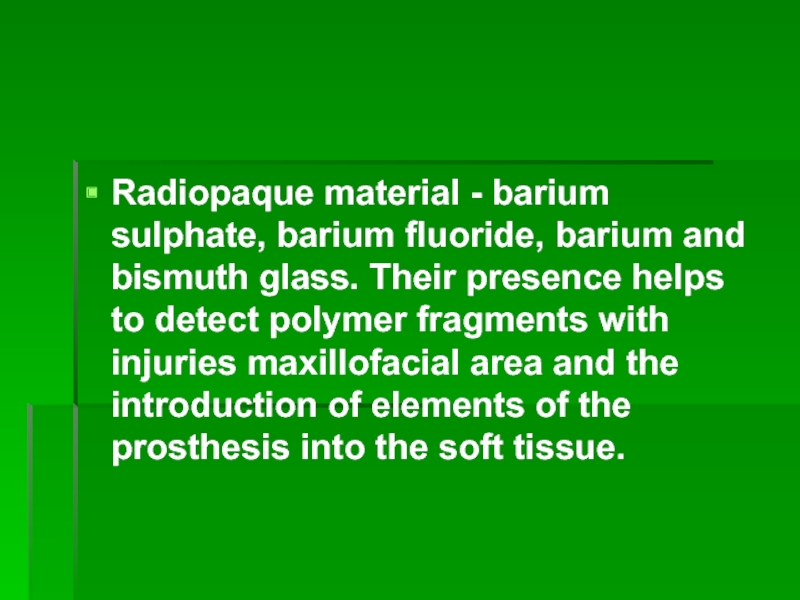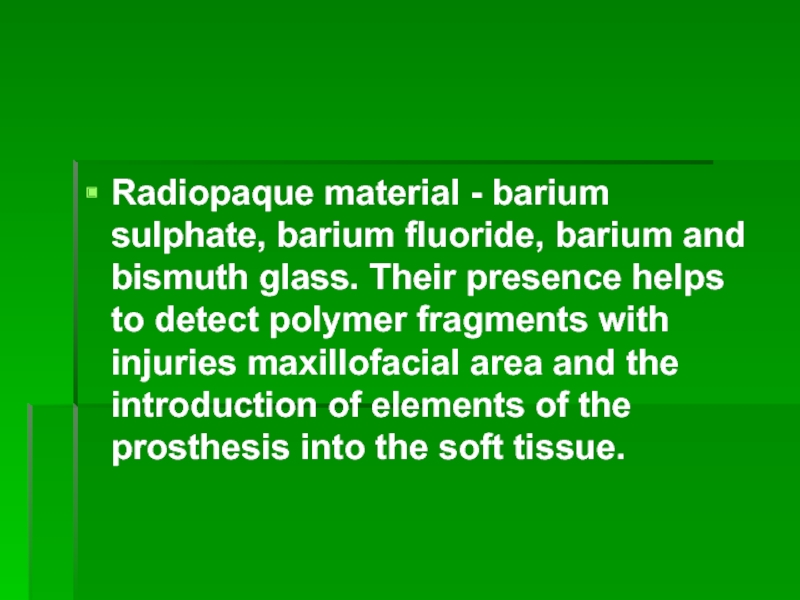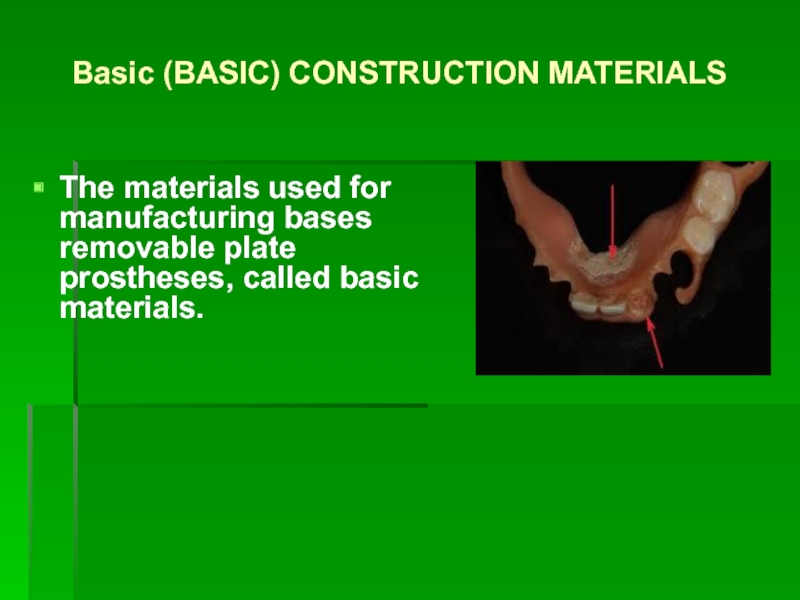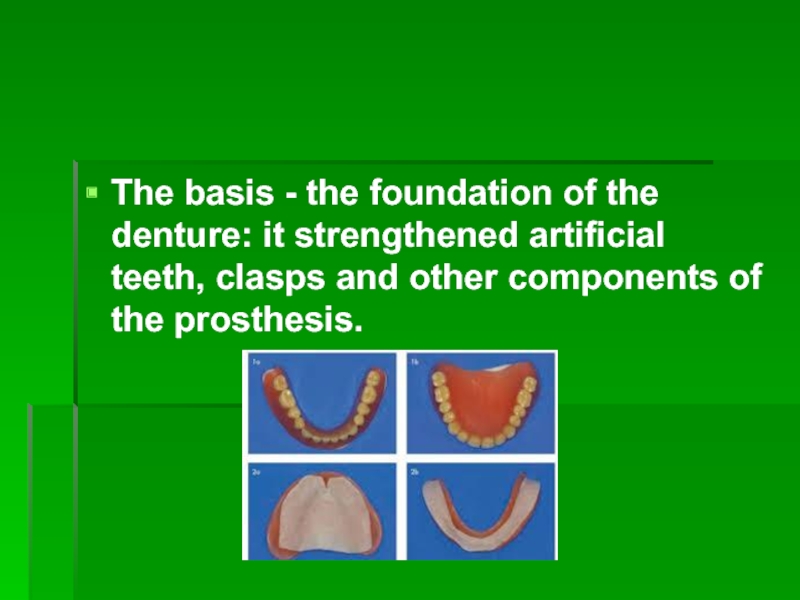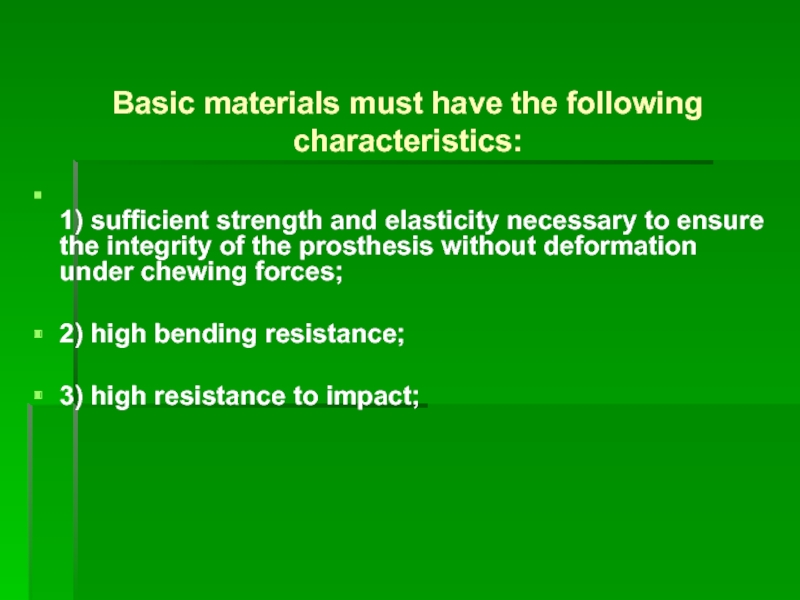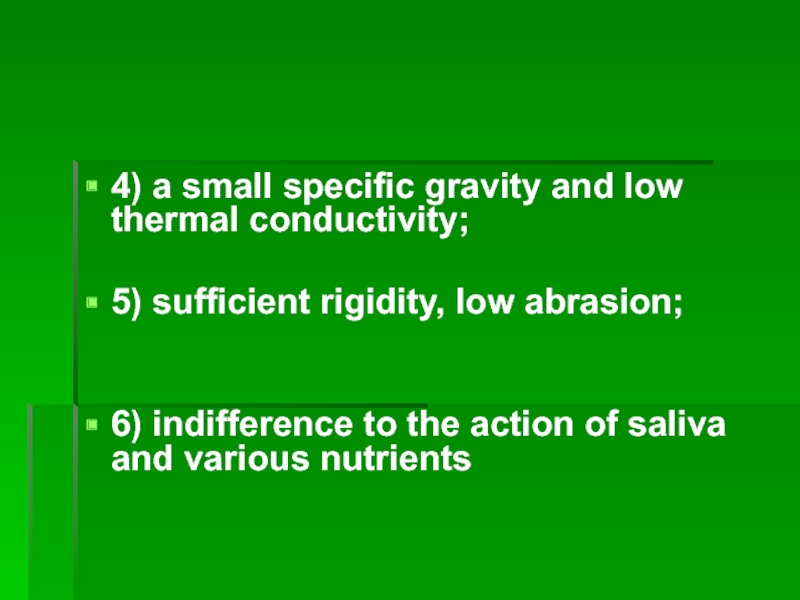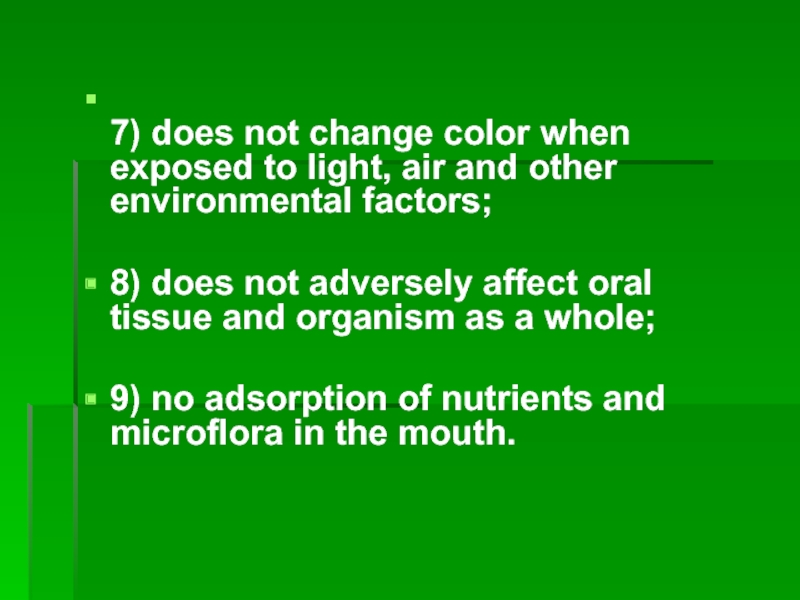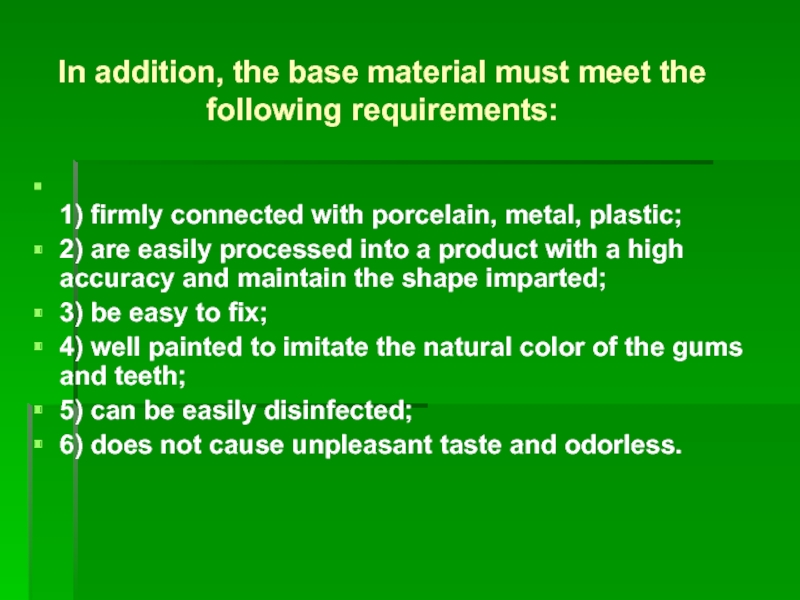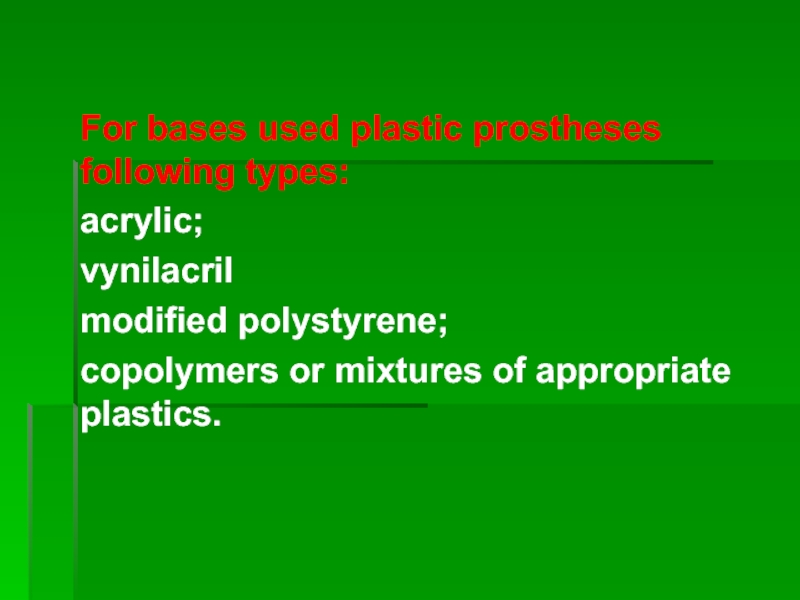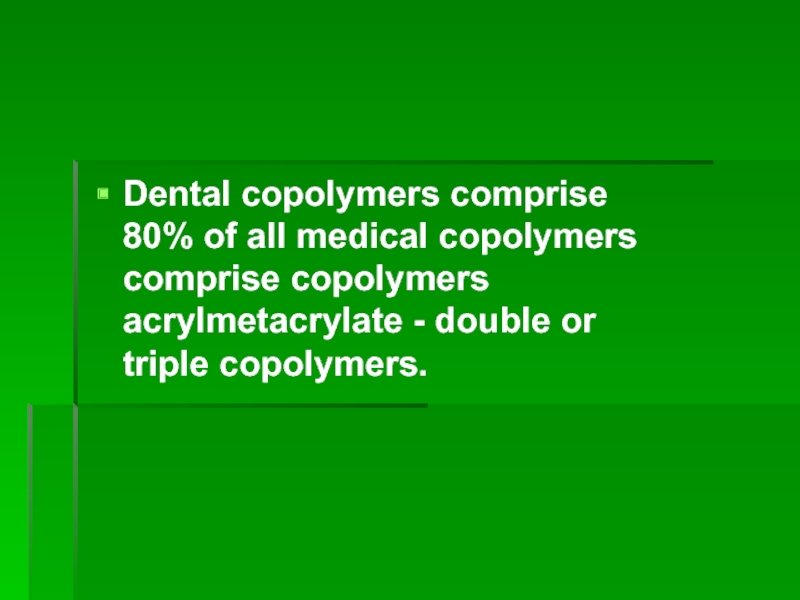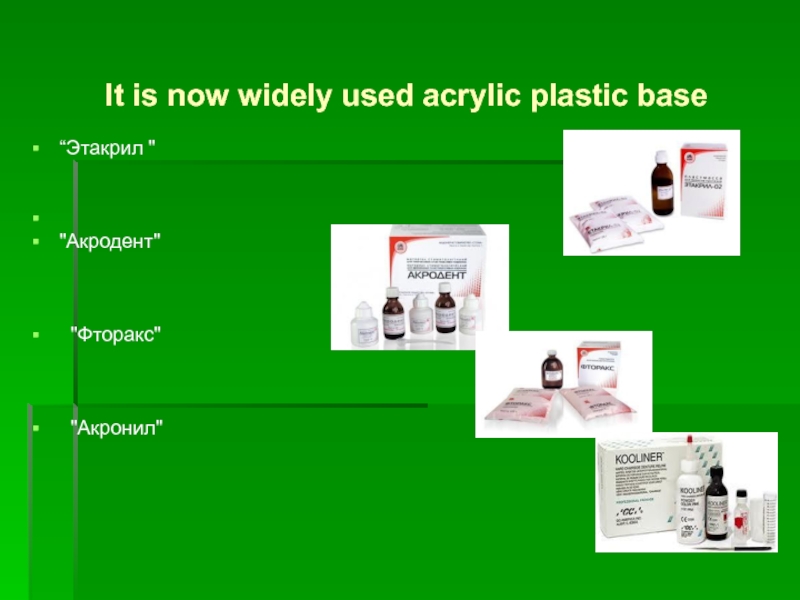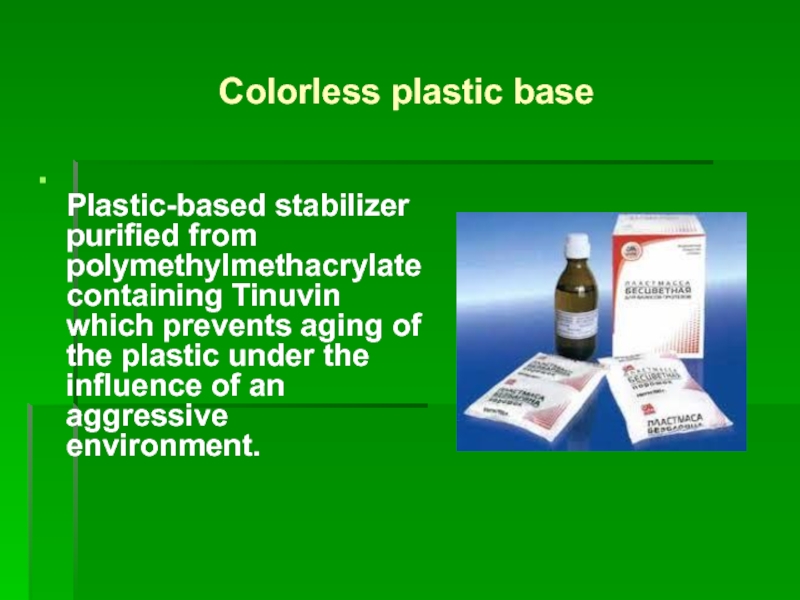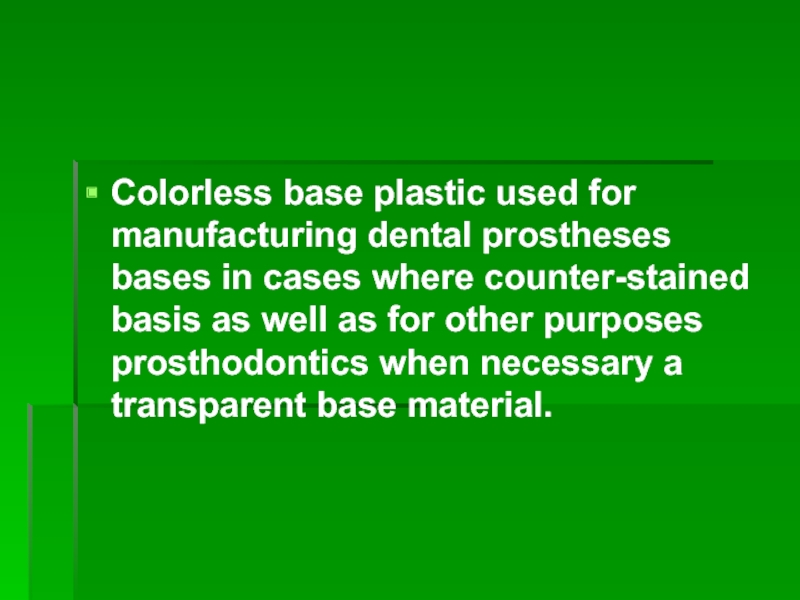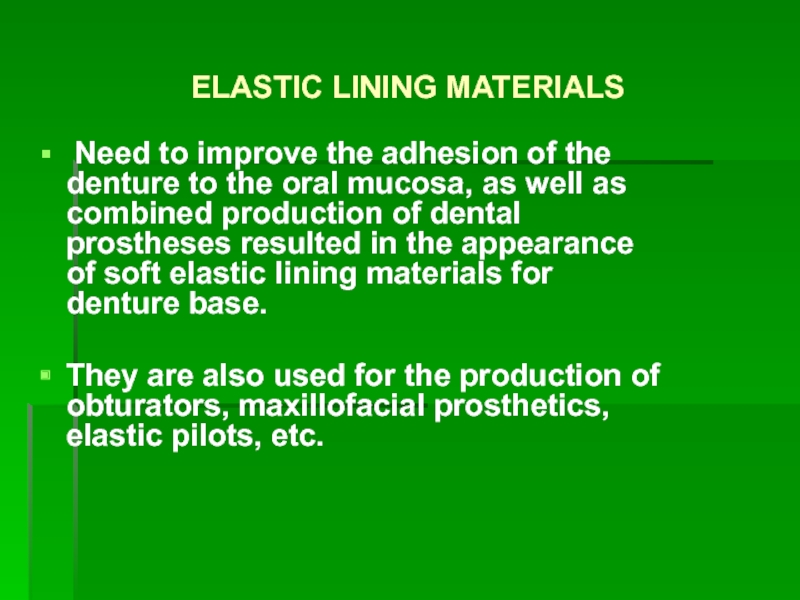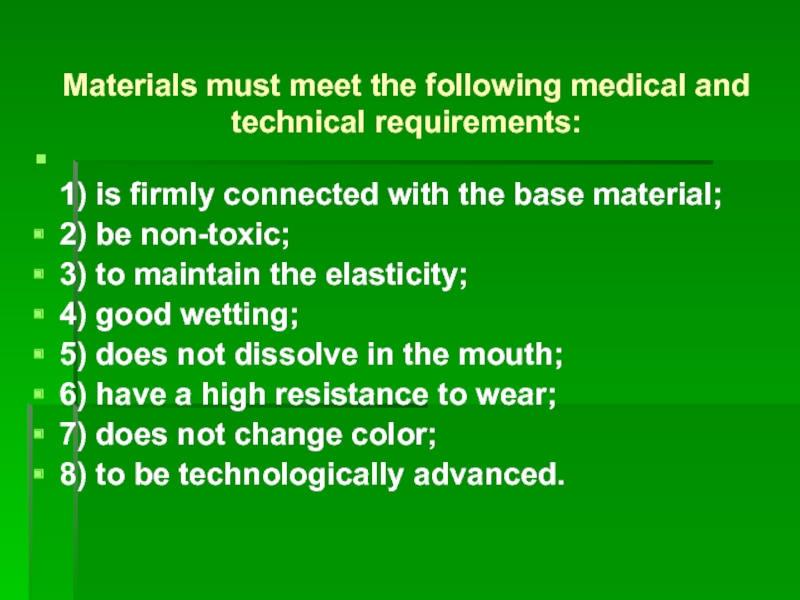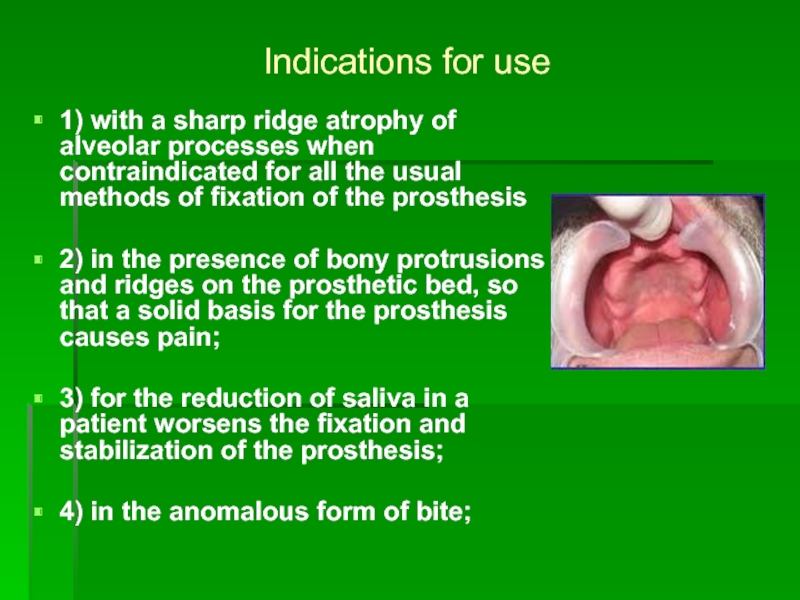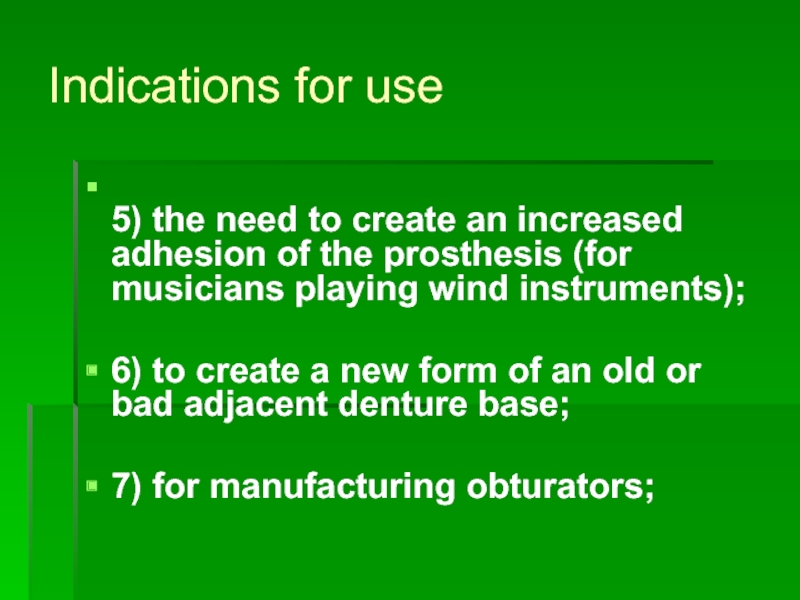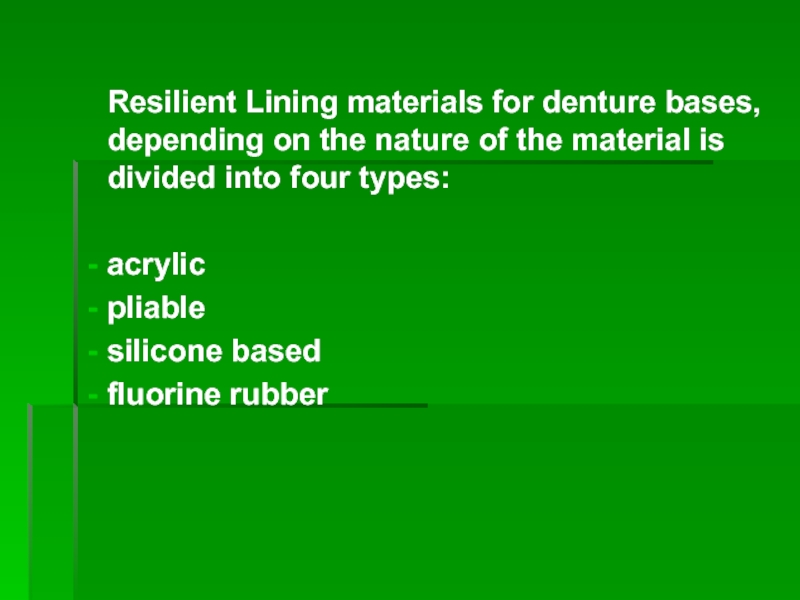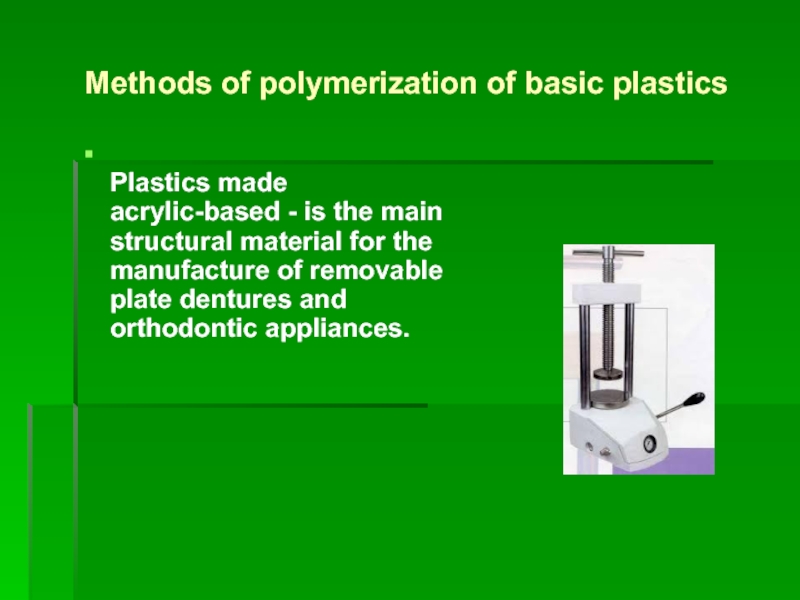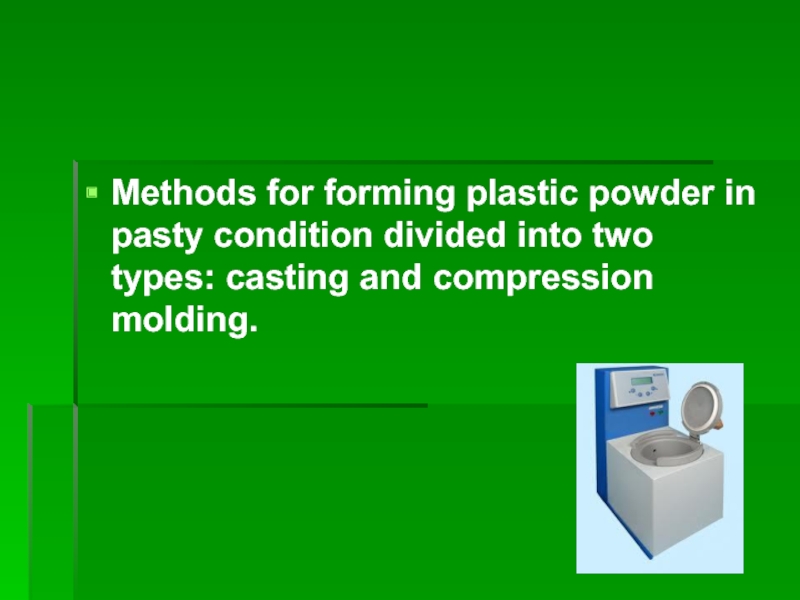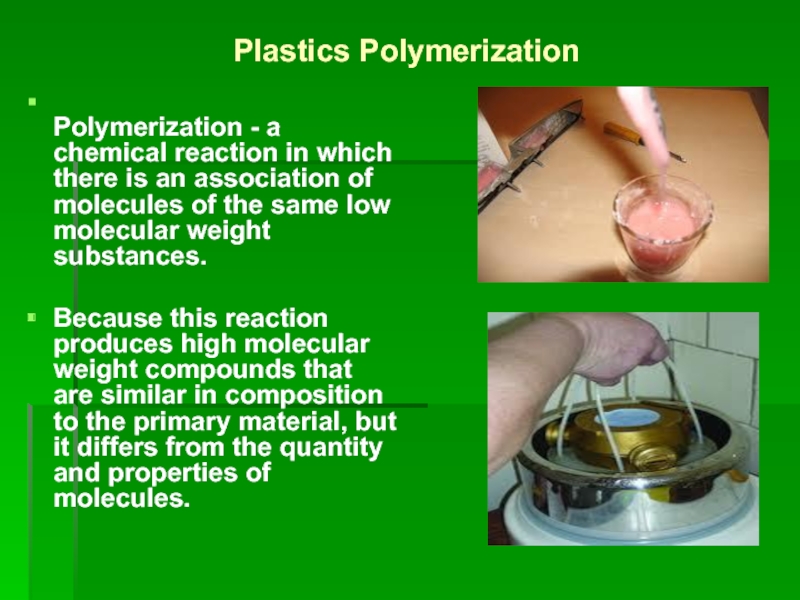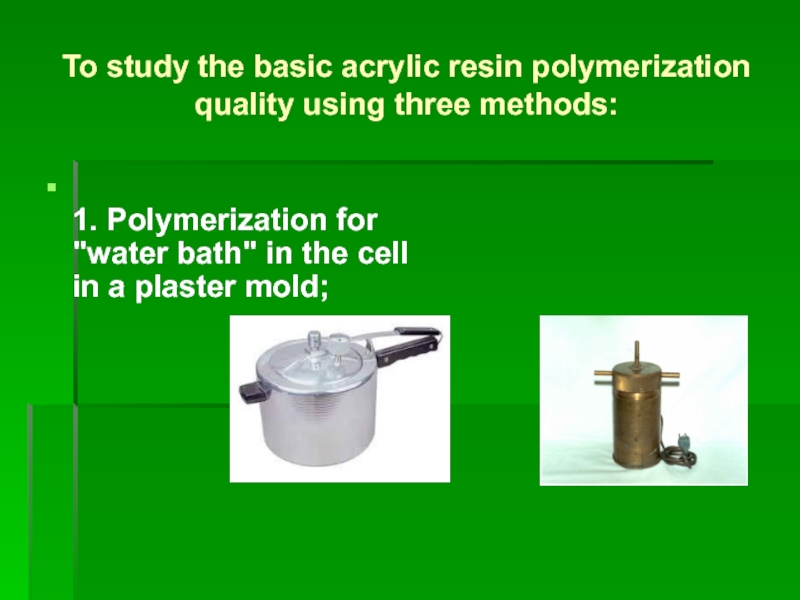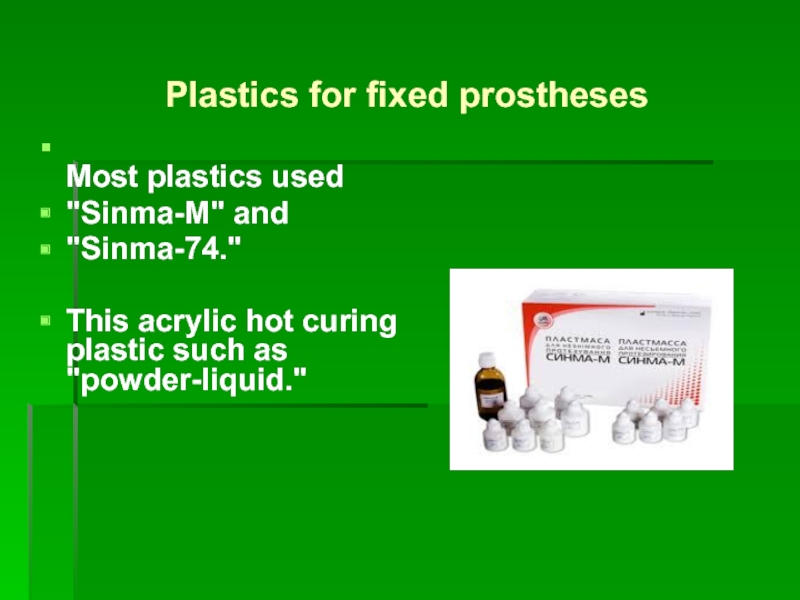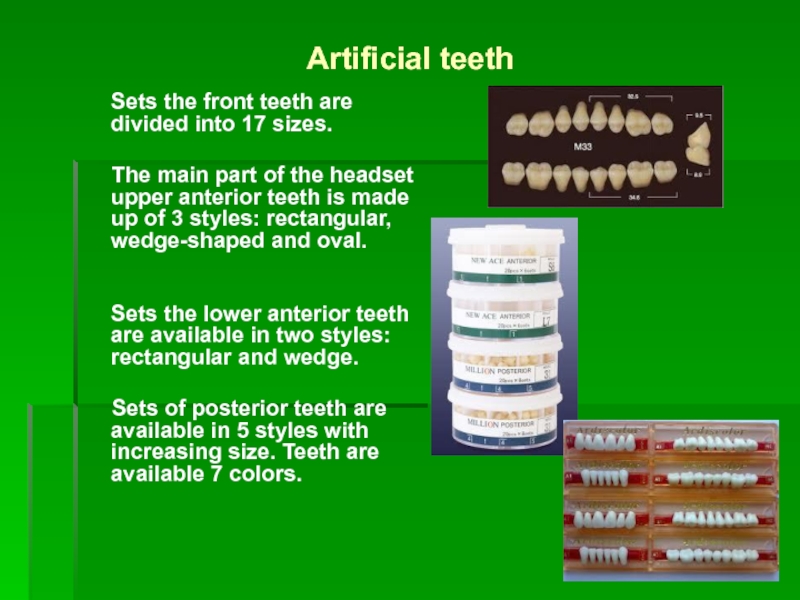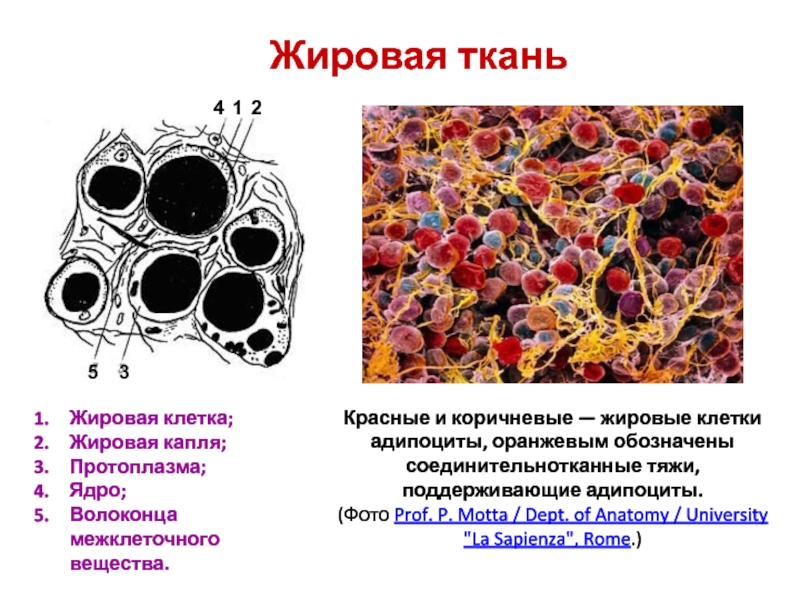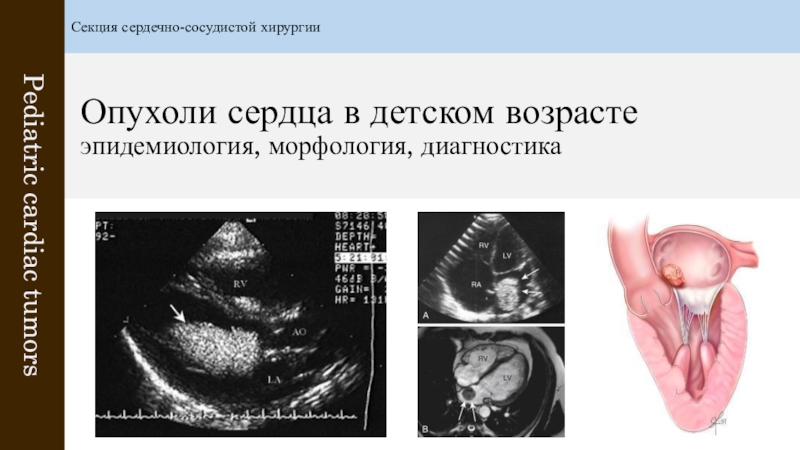Разделы презентаций
- Разное
- Английский язык
- Астрономия
- Алгебра
- Биология
- География
- Геометрия
- Детские презентации
- Информатика
- История
- Литература
- Математика
- Медицина
- Менеджмент
- Музыка
- МХК
- Немецкий язык
- ОБЖ
- Обществознание
- Окружающий мир
- Педагогика
- Русский язык
- Технология
- Физика
- Философия
- Химия
- Шаблоны, картинки для презентаций
- Экология
- Экономика
- Юриспруденция
"Plastics. General characteristics. Classification. Composition. The main types
Содержание
- 1. "Plastics. General characteristics. Classification. Composition. The main types
- 2. Plastics - materials, which are based on
- 3. The main starting materials for polymer
- 4. Polymerization - reaction interconnection monomer compounds
- 5. Classification of plastics: 1. origin include:
- 6. 2. By nature: • organic; • inorganic; • organ elemental.
- 7. Main, which are used for removable and
- 8. B) Support, which are used at different
- 9. B) Clinicalthe temperature conditions of polymerization plastics
- 10. Physical properties of materialsSpecific gravity -
- 11. Mechanical properties of materials Durability - solid
- 12. Elasticity - material property again to
- 13. KEY (CONSTRUCTION) MATERIALS They should be
- 14. The basic materials include:PlasticPorcelain Artificial teethMetals
- 15. The major components of this type
- 16. Compound of plasticThe main component fluids "monomer"
- 17. Compound of plastic Filler - a substance
- 18. Pigment - a substance imparting dental polymeric
- 19. The catalyst - a substance that accelerates
- 20. Activator - an agent that causes
- 21. Radiopaque material - barium sulphate, barium fluoride,
- 22. Radiopaque material - barium sulphate, barium fluoride,
- 23. Basic (BASIC) CONSTRUCTION MATERIALSThe materials used for manufacturing bases removable plate prostheses, called basic materials.
- 24. The basis - the foundation of the
- 25. Basic materials must have the following
- 26. 4) a small specific gravity and low
- 27. 7) does not change color when
- 28. In addition, the base material must meet
- 29. For bases used plastic prostheses following
- 30. Dental copolymers comprise 80% of all medical copolymers comprise copolymers acrylmetacrylate - double or triple copolymers.
- 31. It is now widely used acrylic plastic base“Этакрил " "Акродент" "Фторакс" "Акронил"
- 32. Colorless plastic base Plastic-based stabilizer purified
- 33. Colorless base plastic used for manufacturing dental
- 34. ELASTIC LINING MATERIALS Need to improve the
- 35. Materials must meet the following medical
- 36. Indications for use 1) with a sharp ridge
- 37. Indications for use 5) the need to
- 38. Resilient Lining materials for denture bases,
- 39. Methods of polymerization of basic plastics
- 40. Methods for forming plastic powder in pasty condition divided into two types: casting and compression molding.
- 41. Plastics Polymerization Polymerization - a chemical reaction
- 42. To study the basic acrylic resin polymerization
- 43. 2. The polymerization to dry under pressure;
- 44. 3. Polymerization an improved apparatus for foundry molding.
- 45. Plastics for fixed prostheses Most plastics
- 46. Artificial teeth Sets the front teeth
- 47. Thank you
- 48. Скачать презентанцию
Plastics - materials, which are based on polymers which are in the period of formation of products in the viscous fluid or highly elastic, and in the operation - in the
Слайды и текст этой презентации
Слайд 2Plastics - materials, which are based on polymers which are
in the period of formation of products in the viscous
fluid or highly elastic, and in the operation - in the glassy or crystalline state.Polymers - a substance whose molecules consist of a large number of repeating units.
Слайд 3 The main starting materials for polymer dental materials are monomers
and oligomers (mono, I-D, tri-, tetra acrylates).
Monocrylat volatile, so
they are using in combination with high molecular weight esters, thereby reducing shrinkage of the polymer.Слайд 4 Polymerization - reaction interconnection monomer compounds with double bonds without
the formation during the reaction of any new substances.
The
reaction generated a high molecular compound that is different from the original size of a molecule.The mechanism of the polymerization reaction is to activate some of the monomer molecules by the action of light, heat or catalysis torus and subsequently joining the already activated molecules to other molecules to form longer chains.
This connection continues as long as the energy is initially activated molecule dissipates.
Слайд 5
Classification of plastics:
1. origin include:
• natural or biopolymers
(proteins, nucleic acids, natural number rubber);
• synthetic (polyethylene, polyamides,
epoxy resins).Слайд 7Main, which are used for removable and fixed dentures:
•
base (rigid) polymers;
• elastic polymers or elastomers;
• polymer
(plastic) artificial teeth;
• polymers for replacement of dental hard tissue defects, materials for fillings, pin teeth and tabs; • polymeric materials for temporary non-removable dentures;
• facing polymers (for permanent fixed prosthesis);
• restoration polymers
Слайд 8B) Support, which are used at different stages of the
manufacture of dentures:
• polymer impression material;
• polymer standard impression
trays; • polymeric materials for the manufacture of individual spoons;
• plastic caps and temporary crown to protect the prepared teeth.
Слайд 9B) Clinical
the temperature conditions of polymerization plastics are "hot" curing;
cold curing plastics ( "self-hardening", "quick-hardening").
In the presence of
"pink" plastic pigments; “colorless" plastics; plastic different color impressions.
Слайд 10
Physical properties of materials
Specific gravity - density of the material,
the amount of substance per unit volume and mass of
one cm3 of the body, expressed in grams.Melting point - the temperature at which the substance passes from a solid to a liquid.
Shrinkage of the material - material volume reduction during cooling after casting.
Слайд 11Mechanical properties of materials
Durability - solid body's ability to resist
the impact of external forces seeking to deform.
Viscosity -
the ability of a material under load to stretch, lengthen. Hardness - The ability of the solid material to enter the soft material under pressure.
Слайд 12 Elasticity - material property again to return to its original
state, acquiring its original shape after the termination of the
deforming force.Plasticity - the ability to change shape and save it as a final deformation.
Fatigue of materials (metals, plastics) occurs when prolonged load, which creates tension.
Removing the friction arises from solid soft material
Слайд 13
KEY (CONSTRUCTION) MATERIALS
They should be harmless, solid, not collapse under
the action of an oral liquid, various nutrients, air, and
the pressure withstand chewing process during manufacture in which the prosthesis is subjected to tension, bending, distortion, temperature action.Dentures should be a natural color, not to have an unpleasant taste and smell are also important availability and cost of material.
Слайд 15
The major components of this type of plastic compositions are:
1)
monomer - based plastics;
2) binder (phenol-formaldehyde resin, or other);
3) fillers (wood flour, asbestos, glass fiber);
Слайд 16Compound of plastic
The main component fluids "monomer" is a methyl
ester of methacrylic acid stabilized inhibitor.
Each liquid contains a
specific modifier to the polymerization type resins and plastics to impart desired performance properties.Слайд 17Compound of plastic Filler - a substance that affects the strength,
hardness, shrinkage, thermal conductivity, resistance to aggressive media. Sometimes minimal
and organic, powdery and fibrous (silica flour, silica gels, silicates, various grades of finely ground glass).Слайд 18Pigment - a substance imparting dental polymeric compositions and shades
of colors, imitating the tooth tissue and mucosa.
Requirements: harmlessness,
distribution uniformity, stability in maintaining the color under the influence of external factors, good optical properties.Слайд 19The catalyst - a substance that accelerates a chemical reaction.
The Initiator - a substance which when exposed to heat
or other factors (activator) decomposes into free radicals polymerization reaction beginning (benzoyl peroxide).Слайд 20 Activator - an agent that causes the decomposition of the
initiator with the formation of active growth promoting radical polymer
chain and polymerization (dimethylparatoluidine, a tertiary amine).Plasticizer - a substance that increases the ductility and elasticity of the material (dibutyl phthalate, dioctyl phthalate).
Inhibitor (retarder) - a substance that slows the chemical reactions, preventing spontaneous polymerization during transport and storage (hydroquinone, diphenylolpropane).
Слайд 21Radiopaque material - barium sulphate, barium fluoride, barium and bismuth
glass. Their presence helps to detect polymer fragments with injuries
maxillofacial area and the introduction of elements of the prosthesis into the soft tissue.Слайд 22Radiopaque material - barium sulphate, barium fluoride, barium and bismuth
glass. Their presence helps to detect polymer fragments with injuries
maxillofacial area and the introduction of elements of the prosthesis into the soft tissue.Слайд 23
Basic (BASIC) CONSTRUCTION MATERIALS
The materials used for manufacturing bases removable
plate prostheses, called basic materials.
Слайд 24The basis - the foundation of the denture: it strengthened
artificial teeth, clasps and other components of the prosthesis.
Слайд 25
Basic materials must have the following characteristics:
1) sufficient strength and
elasticity necessary to ensure the integrity of the prosthesis without
deformation under chewing forces;2) high bending resistance;
3) high resistance to impact;
Слайд 264) a small specific gravity and low thermal conductivity;
5)
sufficient rigidity, low abrasion;
6) indifference to the action of
saliva and various nutrientsСлайд 27 7) does not change color when exposed to light, air
and other environmental factors;
8) does not adversely affect oral
tissue and organism as a whole; 9) no adsorption of nutrients and microflora in the mouth.
Слайд 28In addition, the base material must meet the following requirements:
1)
firmly connected with porcelain, metal, plastic;
2) are easily processed
into a product with a high accuracy and maintain the shape imparted; 3) be easy to fix;
4) well painted to imitate the natural color of the gums and teeth;
5) can be easily disinfected;
6) does not cause unpleasant taste and odorless.
Слайд 29
For bases used plastic prostheses following types:
acrylic;
vynilacril
modified
polystyrene;
copolymers or mixtures of appropriate plastics.
Слайд 30Dental copolymers comprise 80% of all medical copolymers comprise copolymers
acrylmetacrylate - double or triple copolymers.
Слайд 32
Colorless plastic base
Plastic-based stabilizer purified from polymethylmethacrylate containing Tinuvin which
prevents aging of the plastic under the influence of an
aggressive environment.Слайд 33Colorless base plastic used for manufacturing dental prostheses bases in
cases where counter-stained basis as well as for other purposes
prosthodontics when necessary a transparent base material.Слайд 34ELASTIC LINING MATERIALS
Need to improve the adhesion of the
denture to the oral mucosa, as well as combined production
of dental prostheses resulted in the appearance of soft elastic lining materials for denture base.They are also used for the production of obturators, maxillofacial prosthetics, elastic pilots, etc.
Слайд 35
Materials must meet the following medical and technical requirements:
1) is
firmly connected with the base material;
2) be non-toxic;
3)
to maintain the elasticity; 4) good wetting;
5) does not dissolve in the mouth;
6) have a high resistance to wear;
7) does not change color;
8) to be technologically advanced.
Слайд 36Indications for use
1) with a sharp ridge atrophy of alveolar
processes when contraindicated for all the usual methods of fixation
of the prosthesis2) in the presence of bony protrusions and ridges on the prosthetic bed, so that a solid basis for the prosthesis causes pain;
3) for the reduction of saliva in a patient worsens the fixation and stabilization of the prosthesis;
4) in the anomalous form of bite;
Слайд 37Indications for use
5) the need to create an increased adhesion
of the prosthesis (for musicians playing wind instruments);
6) to
create a new form of an old or bad adjacent denture base; 7) for manufacturing obturators;
Слайд 38 Resilient Lining materials for denture bases, depending on the nature
of the material is divided into four types:
acrylic
pliable
silicone based
fluorine rubber
Слайд 39
Methods of polymerization of basic plastics
Plastics made acrylic-based - is
the main structural material for the manufacture of removable plate
dentures and orthodontic appliances.Слайд 40Methods for forming plastic powder in pasty condition divided into
two types: casting and compression molding.
Слайд 41Plastics Polymerization
Polymerization - a chemical reaction in which there is
an association of molecules of the same low molecular weight
substances.Because this reaction produces high molecular weight compounds that are similar in composition to the primary material, but it differs from the quantity and properties of molecules.
Слайд 42To study the basic acrylic resin polymerization quality using three
methods:
1. Polymerization for "water bath" in the cell in a
plaster mold;Слайд 45
Plastics for fixed prostheses
Most plastics used
"Sinma-M" and
"Sinma-74."
This
acrylic hot curing plastic such as "powder-liquid."
Слайд 46
Artificial teeth
Sets the front teeth are divided into 17 sizes.
The main part of the headset upper
anterior teeth is made up of 3 styles: rectangular, wedge-shaped and oval.Sets the lower anterior teeth are available in two styles: rectangular and wedge.
Sets of posterior teeth are available in 5 styles with increasing size. Teeth are available 7 colors.
